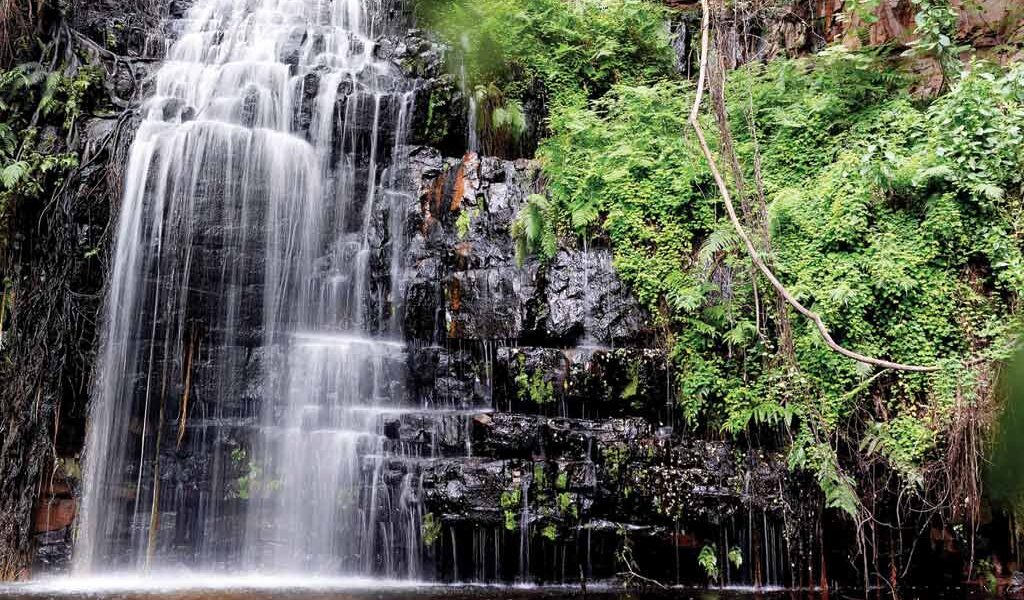GOSEGO MOTSUMI
My first hiking experience was a week ago at Goo Moremi Gorge. Situated about 70 km east of Palapye and nestled in Tswapong hills behind Moremi village the gorge is one of Botswana’s tourist destination of choice. In a bid to create awareness about the historically and spiritually rich gorge, Botswana Tourism extended an invitation for us to go and explore the fern fringed lagoons in the Tswapong area.
Reading through the invite, I imagined that I would be walking trails through the hills and wandering on paved paths surrounded by beautiful trees and breathtaking views. It wasn’t until I was actually out there hiking up the hills that I realized how a hiking trail can be incredibly challenging yet adventurous.
Early Saturday morning my heart was pounding uncontrollably at the starting point when our guide Thapelo Tico Kwadiba said the hike would last for five hours and the return trip from the hills was about 5 km. I had not been physically active, eating everything under the sun and wanted to give up before the hike even began, “You will be fine, walk behind me and follow my steps,” Tico assured me before adding that the aim was to see the five waterfalls, the water source and finally the Vulture’s Gorge on top of the hills.
Each one of us was handed a walking stick to support ourselves through the rocky path. In a linear form, we set out into the unknown. A few metres from the starting point Tico stopped and showed us one of the landmarks, the Sir Seretse Khama Alarm Stone. It is a huge rock believed to have once formed part of one of the hills above. The boulder is said to have fallen at approximately 2 to 5 am on the 13th July 1980. “The locals say they heard a loud noise coming from the gorge when the rock fell off. Early that morning, news arrived that Sir Seretse Khama, the great chief of the Bangwato tribe had passed away. It is therefore believed that the boulder’s fall was symbolic of the passing of a great chief,” Tico explained.
Just a stone throw away we were introduced to the first waterfall, our guide told us the water pool had supernatural powers and no one was allowed to swim as they were reserved for Badimo (ancestors). Interesting revelation but Tico quickly ended it by saying ancestors are not spoken of.
Trekking into Goo Moremi gorge is like walking into the amazon, it is a diverse vegetative habitat with many healthy green tree species, flowing waters and springs. This is where the more challenging track begins: the hiking trails meandered through even steeper hills. Along the way, Tico would yell, “Le boneng Mmabi (watch out for the mountain tree needle). “If you touch this tree you would feel a burning sensation,” he warned us. He also revealed that there were no fishes in the ponds but crabs. We stumbled upon a few crabs and a couple of snakes, which Tico silently chased out of the way fearing that I might jump off the cliffs in panic.
At about 1 km deep in the gorge, we all started feeling it. My legs were heavy and I wanted to give up. Thankfully, Tico was accustomed to long hikes and gave me effective tips for getting through the tough moments. Utilizing the hiking skills he equipped me with, I got up and fought my way forward. To give you a scenario of how challenging it was, we had to hold on to wet slippery rocks to climb up being careful not to step on loose rocks or landing on an thorny tree.
One step, crawl and climb at a time led us to the most breathtaking views of more waterfalls deep within the hills. We saw all five of them and each time we left for another we wanted to see more. Tico would only give us a limited break, probably knowing that we wouldn’t get back up if we stayed for too long.
Before embarking on this trail is it highly advisable to wear the right hiking gear, carry fruits and water. But lucky for us the water from the falls was safe to drink. “The water is safe and clean because it is filtered by the tree roots it passes through,” Tico assured us before we indulged.
Moreover, Goo Moremi Gorge is home to the Cape Vulture and White Backed vulture. The Cape vulture is classified as endangered by the International Union for Conservation of Nature and the gorge is one of only two breeding sides in Botswana.
The Vulture’s Gorge was our final destination before heading back to the starting point. Trailing up the hill was the hardest but slow and steady paces carried us through. Finally, we all made it to the summit, looking out at the hills from miles above, vultures flying peacefully above us and we felt that overwhelming sense of accomplishment. The serene view of the Tswapong area and fresh air numbed the pain. That satisfaction of completing a long hike started to kick in.
We made it back in time before sunset. Tico said it was advisable to return earlier or we would hear strange sounds along the way if we delayed. Hiking Goo Moremi Gorge was one of the most physically challenging experiences of my life and also one of the most exhilarating, but I’d do it again if I have to.

